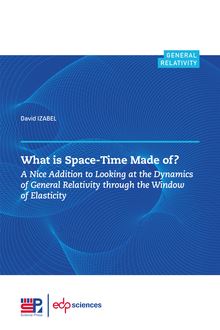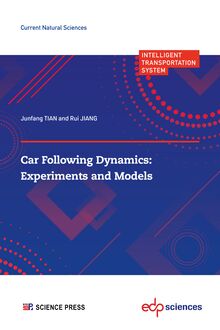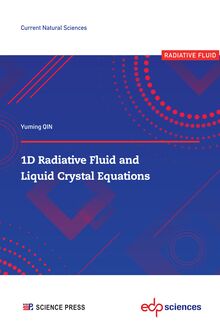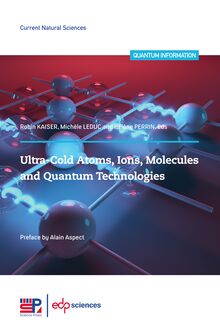Theoretical Framework and Techniques for Laser Detection Utilizing Coherence , livre ebook
208
pages
English
Ebooks
2025
Obtenez un accès à la bibliothèque pour le consulter en ligne En savoir plus
Découvre YouScribe en t'inscrivant gratuitement
Découvre YouScribe en t'inscrivant gratuitement
208
pages
English
Ebooks
2025
Obtenez un accès à la bibliothèque pour le consulter en ligne En savoir plus
Publié par
Date de parution
02 janvier 2025
Nombre de lectures
0
EAN13
9782759836819
Langue
English
Poids de l'ouvrage
34 Mo
This book introduces the theories and methods of laser coherent detection in the field of high-performance target detection. It includes five chapters, including the theoretical foundation of laser coherent detection, laser coherent detection of atmospheric disturbances, the chirped amplitude-modulated (AM) laser coherent detection of range and velocity, laser coherent detection based on the micro-Doppler effect, and laser coherent detection of synthetic aperture lidars (SALs).
The book offers an invaluable resource for researchers, especially those who are engaged in fields including laser imaging, photoelectric information acquisition, target detection and recognition, and laser technology. Additionally, it can be used as a reference book for professional teachers, advanced undergraduates, and postgraduates of relevant majors.
Contents
Preface . . . . . . . . . . . . . . . . . . . . . . . . . . . . . . . . . . . . . . . . . . . . . . . . . . . . . III
Foreword . . . . . . . . . . . . . . . . . . . . . . . . . . . . . . . . . . . . . . . . . . . . . . . . . . . V
CHAPTER 1
Theoretical Basis of Laser Coherent Detection . . . . . . . . . . . . . . . . . . . . . . . 1
1.1 Overview of Laser Detection . . . . . . . . . . . . . . . . . . . . . . . . . . . . . . . . 1
1.2 Principles of Laser Coherent Detection . . . . . . . . . . . . . . . . . . . . . . . . 2
1.2.1 Square-Law Characteristic of Photoelectric Detectors . . . . . . . . 3
1.2.2 Characterization of Laser Coherent Detection Signals . . . . . . . . 3
1.3 Signal-to-Noise Ratio of Laser Coherent Detection . . . . . . . . . . . . . . . 5
1.3.1 Noise of Photoelectric Detectors . . . . . . . . . . . . . . . . . . . . . . . . 5
1.3.2 Signal-to-Noise Ratio of Coherent Detection . . . . . . . . . . . . . . . 7
1.4 Coherence Efficiency of Laser Coherent Detection . . . . . . . . . . . . . . . . 9
1.4.1 Signal and LO Optical Fields . . . . . . . . . . . . . . . . . . . . . . . . . . 9
1.4.2 Coherence Efficiency Analysis. . . . . . . . . . . . . . . . . . . . . . . . . . 11
1.5 Basic Characteristics of Laser Coherent Detection . . . . . . . . . . . . . . . . 11
1.6 Overview of Typical Applications of Laser Coherent Detection . . . . . . 13
1.6.1 Laser Detection of Atmospheric Disturbances . . . . . . . . . . . . . . 13
1.6.2 Laser Ranging and Velocity Measurement . . . . . . . . . . . . . . . . 17
1.6.3 Laser Detection Based on the Micro-Doppler Effect . . . . . . . . . 20
1.6.4 High-Resolution Synthetic Aperture Laser Imaging . . . . . . . . . 23
References . . . . . . . . . . . . . . . . . . . . . . . . . . . . . . . . . . . . . . . . . . . . . . . . . . 27
CHAPTER 2
Laser Coherent Detection of Atmospheric Disturbances . . . . . . . . . . . . . . . . 29
2.1 Fundamental Principles . . . . . . . . . . . . . . . . . . . . . . . . . . . . . . . . . . . . 29
2.1.1 Radar Equation for Laser Detection of Atmosphere . . . . . . . . . 29
2.1.2 Fundamental Principles of Laser Coherent Atmospheric CO2 Detection . . . . . . . . .. 32
2.1.3 Fundamental Principles of Laser Coherent Detection of Wind-Field Disturbances. . . .. 39
2.2 Experimental System for Laser Coherent Detection of Atmospheric Disturbances . . . . . . . 42
2.2.1 Overall Structure of the Detection System . . . . . . . . . . . . . . . . 42
2.2.2 Parameter Design of the Detection System . . . . . . . . . . . . . . . . 46
2.2.3 Pulse Data Processing of Detection Echoes . . . . . . . . . . . . . . . 57
2.3 Laser Coherent Detection Experiments of Atmospheric Disturbances. . 62
2.3.1 Atmospheric CO2 Detection Experiments . . . . . . . . . . . . . . . . . 62
2.3.2 Atmospheric Wind-Field Detection Experiments . . . . . . . . . . . 68
References . . . . . . . . . . . . . . . . . . . . . . . . . . . . . . . . . . . . . . . . . . . . . . . . . . 74
CHAPTER 3
Chirped AM Laser Coherent Detection of Range and Velocity . . . . . . . . . . . 77
3.1 Fundamental Principles . . . . . . . . . . . . . . . . . . . . . . . . . . . . . . . . . . . . 77
3.1.1 Principle of Chirped AM Ranging . . . . . . . . . . . . . . . . . . . . . . 79
3.1.2 Principle of Chirped AM Velocity Measurement . . . . . . . . . . . . 79
3.2 Characteristics of Chirp Signals and De-Chirping . . . . . . . . . . . . . . . . 80
3.2.1 Chirp Signals and Their Ambiguity Function . . . . . . . . . . . . . . 80
3.2.2 Pulse Compression by a Matched Filter . . . . . . . . . . . . . . . . . . 83
3.2.3 Frequency-Domain Pulse Compression of Chirp Signals . . . . . . 84
3.2.4 Range-Velocity Coupling . . . . . . . . . . . . . . . . . . . . . . . . . . . . . 86
3.3 Balanced Coherent Detection . . . . . . . . . . . . . . . . . . . . . . . . . . . . . . . 87
3.4 Chirped AM Laser Coherent Detection Experiment of Range and Velocity . . . . . . 88
3.4.1 Chirped AM Laser Heterodyne Coherent Detection Experiments of Range . . . . . . 89
3.4.2 Chirped AM Laser Homodyne Coherent Detection Experiments of Range and Velocity . . 95
References . . . . . . . . . . . . . . . . . . . . . . . . . . . . . . . . . . . . . . . . . . . . . . . . . . 102
CHAPTER 4
Laser Coherent Detection Based on the Micro-Doppler Effect . . . . . . . . . . . . 103
4.1 Fundamental Principles of the Micro-Doppler Effect for Laser Detection . . . . . 103
4.1.1 Doppler and Micro-Doppler Effects . . . . . . . . . . . . . . . . . . . . . 103
4.1.2 Modeling of Echoed Photocurrent Signals in Target Vibration Detection . . . . 105
4.1.3 Modeling of Echoed Photocurrent Signals of Targets with Multiple Scattering Points. . . . 108
4.1.4 Influencing Factors of Characteristics of Laser Micro-Doppler Signals . . . . . . . . 112
4.2 Target Micro-Doppler Signal Acquisition and Experimental System for Laser Coherent Detection . . . . . . . . . . . . . . . . . . . . . . . . . . . . . . . 119
4.3 Target Micro-Motion Feature Extraction Based on TFA . . . . . . . . . . . 121
4.3.1 TFA of Micro-Doppler Signals of Targets . . . . . . . . . . . . . . . . . 121
4.3.2 Decomposition of Time–Frequency Features of Multi-Component Signals Based on Curve Tracking . . . . . . . 125
4.3.3 Separation and Extraction of Time–Frequency Features of Micro-Motions Based on Empirical Mode Decomposition . . . 128
4.4 Micro-Motion Parameter Estimation Based on Signal Models . . . . . . . 132
4.4.1 Micro-Motion Parameter Estimation Using PF Based on SPM . 132
4.4.2 Micro-Motion Parameter Estimation Based on ML. . . . . . . . . . 136
References . . . . . . . . . . . . . . . . . . . . . . . . . . . . . . . . . . . . . . . . . . . . . . . . . . 152
CHAPTER 5
Laser Coherent Detection Using Synthetic Aperture Technology . . . . . . . . . . 155
5.1 Fundamental Principles of SALs . . . . . . . . . . . . . . . . . . . . . . . . . . . . . 155
5.1.1 Intuitive Concept of Synthetic Aperture in Lidars . . . . . . . . . . 155
5.1.2 Echo Signal Model of SALs . . . . . . . . . . . . . . . . . . . . . . . . . . . 157
5.1.3 Fundamental Principles of Coherent Mixing of Chirp Signals . . 160
5.2 SAL Imaging Algorithms . . . . . . . . . . . . . . . . . . . . . . . . . . . . . . . . . . 162
5.2.1 R-D Imaging Algorithm . . . . . . . . . . . . . . . . . . . . . . . . . . . . . . 162
5.2.2 Phase Gradient Autofocus Algorithm . . . . . . . . . . . . . . . . . . . . 170
5.3 Laser Coherent Detection Experiments Using Synthetic Aperture Technology. . . . . . . . 173
5.3.1 Structure of the Experimental System . . . . . . . . . . . . . . . . . . . 173
5.3.2 Data Processing Flow . . . . . . . . . . . . . . . . . . . . . . . . . . . . . . . 177
5.3.3 Analysis of Experimental Results . . . . . . . . . . . . . . . . . . . . . . . 178
References . . . . . . . . . . . . . . . . . . . . . . . . . . . . . . . . . . . . . . . . . . . . . . . . . . 194
Publié par
Date de parution
02 janvier 2025
Nombre de lectures
0
EAN13
9782759836819
Langue
English
Poids de l'ouvrage
34 Mo














